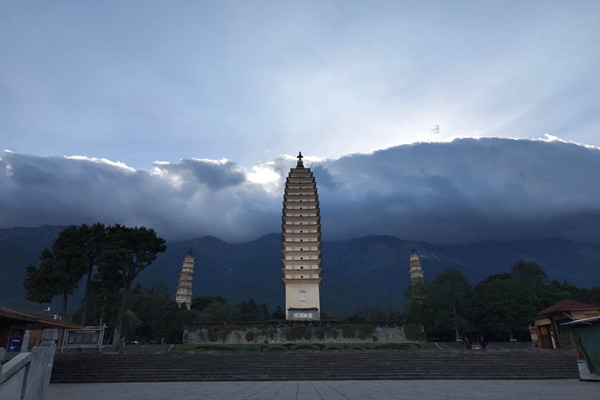Bridges, streams and old abodes: Spring scenes of Yunnan bewitch visitors
- By Wu Jin
 0 Comment(s)
0 Comment(s) Print
Print E-mail China.org.cn, April 26, 2017
E-mail China.org.cn, April 26, 2017
Leg Four: Dali
Chongsheng Temple
|
|
|
Three equi-distant pagodas in Chongsheng Temple signal an ancient architecture that can be traced back more than 1,000 years. [Photo by Vigor Scrofa / China.org.cn] |
The three pagodas of the Chongsheng Temple in Dali, the city home to the Bai Ethnic Group, is a Buddhist religious site with a history of more than 1,000 years. With their octagonal eaves, a norm of local architecture, the three equi-distant towers have a transverse section forming an equilateral triangle.
Cangshan
Standing as a border, south of which there are no mountains able to reach as high as 3,500 meters, the snow-capped Mt. Cangshan is replete with waterfalls. Its seven lagoons in the middle of the mountain shaped by cascades of annual melting snow have been romanticized as Swimming Pools for the Seven Dragon Divinities. The causeway paved to connect three different cable car stations serves as a sightseeing corridor for visitors to experience the bushy and tranquil retreat, is called the Jade Belt of the Divinities. When rays of the setting sun penetrate the clouds and shed light on the mountain, dying it in immense and fierce redness, there is a splendid picture that resembles the legendary Buddha Light on Earth.
Leg Five: Kunming
Mt. West
Facing the vast Dian Lake, dubbed as the pearl on China’s southwestern plateau, Mt. West in Kunming is home to a cluster of halls and sites that well demonstrate the essence of Chinese culture, a combination of Confucianism, Buddhism and Daoism. Although visitors may need to take a cableway across the lake to the mountain, the sites they reach, such as Lingxu Cabinet, Gate of Dragon (the crossing of which could mean one winning first position in the imperial exam) and a stone fictionalized as an abandoned one when the Chinese goddess had managed to fill the crevices of the sky, are full of cultural and natural features that form a feast for the eyes and hearts.
Overlooking the Dian Lake, one can enjoy a scene of rippling waves and swirling vapor. At the same time, the sites of the mountain enshrined with legends reflecting the values of Chinese conventional culture, such as filial piety, benevolence and longevity, have indicated the belief, faith and merits of the Chinese people.
Jiangwu Military School
|
|
|
Jiangwu School, one of China’s earliest modern military schools [Photo by Vigor Scrofa / China.org.cn] |
The memories of numerous defeats in wars in the last two centuries suffered by China always reminds people of the humiliating history and their brave predecessors, thanks to whose sweat, agonies and sacrifices the nation was able to rise again. The site of Jiangwu Military School, one of China’s earliest ground military army training institutes, established by the legendary General Cai E (1882-1916), known for his struggle against Yuan Shikai’s proclamation as emperor in 1915, and flourishing at the hands of Tang Jiyao (1883-1927), a revolutionary-turned-magistrate in Yunnan, is a reminiscent historic spot. A constellation of brave men, such as, Marshal Zhu De (1886-1976) and Ye Jianying (1897-1986), were among the alumni of the school, where they received military training before heading for the battlefields. Their sweat and blood to which we are much indebted have rescued the country from the abyss of chaos and enslavement and redirected its path to peace and prosperity.








Go to Forum >>0 Comment(s)